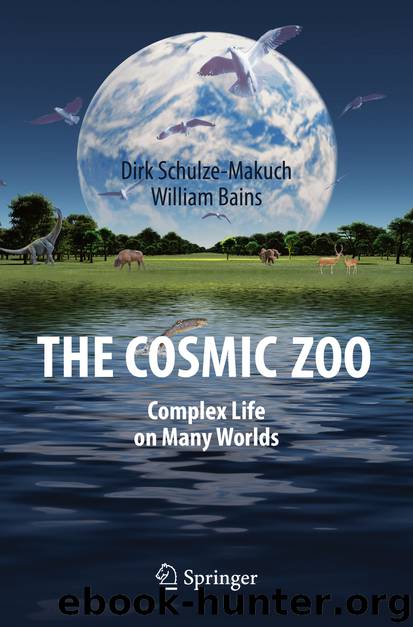The Cosmic Zoo by Dirk Schulze-Makuch & William Bains

Author:Dirk Schulze-Makuch & William Bains
Language: eng
Format: epub
Publisher: Springer International Publishing, Cham
8.4 Multicellularity on Earth and Other Planets
We have seen from the ideas above that the evolution to multicellularity does not appear to be a distinct step, but more a continuous hill that was climbed on the way to increased complexity. How likely is that to occur?
Only eukaryotes can be obligately multicellular . We discussed the appearance of eukaryotes in Chap. 6, and argued there that the appearance of complex cells, either by endosymbiosis or interior partitioning, is a Many Paths process. In this chapter we have argued that the steps along the way to multicellularity are apparently relatively simple. Note that we are not saying that any of these steps are ‘easy’—they take the accumulation of many genetic changes. But there are many combinations of genes , Many Paths, that can result in that endpoint, and so given time it is likely to happen.
With these two pieces in place, we can say confidently that multicellular life is common, indeed almost inevitable, because it has arisen many times. If that is so, we would expect multicellularity to evolve multiple times on the Earth. And it has.
Many distantly related branches of the eukaryotic tree of life hold multicellular life forms. In particular, these include Ophistokonts, and plants. The Ophistokonts are a diverse group of organisms that include animals, all of which are multicellular , uni- and multicellular fungi , unicellular microsporidia (also a type of fungi ), and choanoflagellates . Within the Ophistokonts, it is clear that multicellularity evolved at least twice, in the ancestors of fungi and animals. Genetic data suggest that these two ancient lineages [technically the holomycota (which include fungi ) and the holozoa (which include animals)] diverged long before there is any evidence of multicellular life on Earth. Thus the originating organisms at the base of the fungal and animal branches were almost certainly unicellular, and multicellularity evolved independently in fungi and animals. It also evolved independently in the plants, whose ancestor diverged from the Ophistokonts not long after the eukaryotes evolved. It is believed likely that land plants and algae evolved multicellularity separately. The plants and fungal groups contain species that are unicellular, others that are facultative multicellular that can easily switch to and fro between unicellular and multicellular life styles, as well as true, obligate multicellular organisms.
Based on what we know from life on Earth, it thus has to be concluded that the transition from unicellular life to multicellular life will inevitably be mastered elsewhere by biology given similar evolutionary pressures. The evolution of consumers (organisms that feed on other organisms, such as animals) seems inevitable once a sufficient number of primary producers (such as plants) is available in an ecosystem . The total biomass would become larger and increasingly complex. A consumer has the advantage of deriving energy directly from organic building blocks rather than having to convert energy from the abiotic environment. An increase in size would provide an organisms a critical advantage, for a producer (prey) to avoid being eaten, and for a
Download
This site does not store any files on its server. We only index and link to content provided by other sites. Please contact the content providers to delete copyright contents if any and email us, we'll remove relevant links or contents immediately.
| Aeronautics & Astronautics | Astronomy |
| Astrophysics & Space Science | Comets, Meteors & Asteroids |
| Cosmology | Mars |
| Solar System | Star-Gazing |
| Telescopes | UFOs |
Tools of Titans by Timothy Ferriss(8212)
Turbulence by E. J. Noyes(7935)
Secrets of Antigravity Propulsion: Tesla, UFOs, and Classified Aerospace Technology by Ph.D. Paul A. Laviolette(5309)
Astrophysics for People in a Hurry by Neil DeGrasse Tyson(5130)
Room 212 by Kate Stewart(5035)
Design of Trajectory Optimization Approach for Space Maneuver Vehicle Skip Entry Problems by Runqi Chai & Al Savvaris & Antonios Tsourdos & Senchun Chai(5011)
Pale Blue Dot by Carl Sagan(4907)
The David Icke Guide to the Global Conspiracy (and how to end it) by David Icke(4624)
A Journey Through Divination and Astronomy by Publishing Pottermore(4340)
Goodbye Paradise(3724)
Apollo 8 by Jeffrey Kluger(3635)
COSMOS by Carl Sagan(3553)
Losing the Nobel Prize by Brian Keating(3498)
The Five People You Meet in Heaven by Mitch Albom(3474)
How to Read Water: Clues and Patterns from Puddles to the Sea (Natural Navigation) by Tristan Gooley(3406)
Brief Answers to the Big Questions by Stephen Hawking(3369)
How to Read Nature by Tristan Gooley(3249)
The Order of Time by Carlo Rovelli(3144)
A Brief History of Time by Stephen Hawking(2959)
